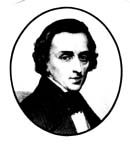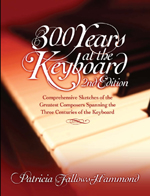Composer Example: Chopin
We have produced a 312 page book that covers 17 of the greatest classical keyboard composers in history. For each composer we give a historical sketch of the composer, commentary on their style, commentary on their more important works and sample sheet music they have produced. We follow this with a comprehensive list of all their works so if you like what a composer is like you can instantly go order some or all of their sheet music.
In this discussion, we will give you a sample of the presentation we do for each composer.

Frédéric François Chopin
Born in Zeiazowa Wola, Poland,
Historical Sketch
Chopin was half French by birth, but by nature and temperament he was
passionately Polish. His French father adopted the cultural traditions of
Poland, became a professor at the Warsaw Lyceum, and married a well-educated
Polish woman who personified the ardent individuality of her countrymen.
Chopin’s musical roots remained in Poland with a life-long national loyalty
in which musical inspiration and patriotism merged. Although he spent many
years in Paris, his music never acquired a “French’’ flavor.
Chopin’s musical development was orderly and rapid. From 1823-26, he studied
in high school and also took lessons with Elsner, director of the Warsaw
Conservatory. He received a solid academic foundation as well as the early
musical discipline of learning Bach and the Viennese Classical composers. On
graduation from high school, he entered the Warsaw Conservatory. Outstanding
for his talent and natural grace, he became a favorite in the salons of
Warsaw aristocracy. Early compositions appeared including the
Rondo Op. 5
(1826),
Là ci darem Variations Op. 2
(1827),
Sonata in C minor Op. 4
(1828),
Fantasia on Polish Airs Op. 13
(1828), and
Krakowiakr Rondo Op. 14
(1828). In 1829, he graduated with
distinction from the Conservatory. His skilled virtuosity at nineteen
assured his reputation as concert pianist and interpreter of his own
compositions.
On a short tour to Vienna shortly after graduation, Chopin featured the
Op. 2 Variations and Krakowiak Rondo. Returning to Warsaw in 1830, he
finished the two
Concertos in E minor Op. 11
and
F minor Op. 21.
With these compositions and the
Polonaise in E flat Op. 22, G minor
Ballade,
and
B minor Scherzo, he left again for Vienna. 1 Eight
months later, after concerts in Breslau, Dresden, Prague, Munich, and
Stuttgart, Chopin left Vienna for Paris. On the way, he learned that Warsaw
had been captured by the Russians. Unable to return to Poland, he became an
exile for the rest of his life.
Chopin settled in Paris. He became a notable figure within a few months
through the success of his first concert on February 26, 1832. He had
formulated strong ideas of pianistic technique as shown in the
Op. 10 Etudes
and was determined to create a new world of musical sound and structure. The
Rothschilds became his patrons, introduced him to French society and
contributed to his financial security. Among his distinguished musical
admirers were Liszt, Berlioz, Mendelssohn, Schumann and the operatic
composers Bellini and Meyerbeer. His early friendship with Liszt cooled; he
disliked Berlioz but respected his music; he was not enthusiastic about
Mendelssohn’s music but was sympathetic to his personality; and finally, he
had little respect for Schumann in spite of Schumann’s early allusion to
him, “Hats off gentlemen, a genius.” With Clara Schumann’s performance of
his music, however, it was a different story; he was impressed with her
intuitive grasp and deftness.
Although he was not robust enough for a virtuoso career and appeared in only
some thirty public performances,2 Chopin developed a compelling musical
image and had considerable income from giving lessons to young women of
society and from the ready sale of his compositions. He was sought after by
writers and artists in the great salons of 19th-Century Paris where the
intellects of the day exchanged compliments, insults, and ideas. The
stimulating atmosphere was congenial to Chopin’s temperament, and he
produced
In the early half of the 19th Century, the piano was developing into an
instrument of a different sound quality from the essential clarity of
Mozart’s, Beethoven’s, and Schubert’s pianos. The Romantic ideals of
increased resonance and dynamic extremes demanded a wider tonal range, and
piano manufacturers began to produce more versatile instruments. Heavier
construction favored larger sound, but on the other hand, hammers now
covered with additional felt produced a more seductive tone. The French
pianos of Pleyel and Érard in the 1830s combined brilliance and mellowness
and were the instruments of Chopin’s choice. Although he could achieve a
striking tone, Chopin in general preferred the subtlety possible within
smaller acoustical bounds. With few exceptions,4 Chopin wrote exclusively
for the piano. Showing penetrating knowledge of hand physiology and keyboard
resources, he composed at the piano and captured pianistic effects from
experiments and innovations of the moment.
Conscious of the unifying power of melody, Chopin remarked that pianists
should hear all the leading singers of the day. Because of his affinity for
vocal art, Chopin found the lyricism of contemporary Italian opera congenial
to his style. His abundant melodies also recalled Schubert’s gift for
continuously singable lines. He added the further development of
chromaticism as an integral part of the melody and separated it from the
function of ornamentation.
A great harmonic innovator of his century, Chopin expanded chromatic harmony
and its accompanying dissonance into…..
Compositions
Chopin’s works in short form include
Mazurkas, Nocturnes, Etudes, Waltzes, Scher-zi, Ballades, Polonaises,
and
Preludes.5 The
Mazurkas, Nocturnes, Waltzes,
and
Polonaises
were published in groups through the
years, each addition representative of some aspect of Chopin’s musical
growth.6 There are also single masterpieces: among them, Fantasie in F
minor, Berceuse, Barcarolle, the two Sonatas in B flat minor and B minor,
and the two Concertos in E minor and F minor. Almost without exception these
works bear Chopin’s arresting, original mark and represent unique advances
in piano literature.
The
Mazurka
was a Polish dance originally, but
Chopin expanded its content as he did with every short form. Among the first
musical nationalists, Chopin had an early interest in Polish folk music. The
Mazurkas
(61),7 in contrast to the dramatic
expan-siveness of the
Polonaises, show a quieter, more condensed
variety possible in their smaller form. Later nationalist composers like
Grieg, Dvorák, Albeniz, Falla, BartÓk, and the Russians developed Chopin’s
lead in incorporating authentic folk songs into Western music. The
Mazurkas, basically ternary………
Lots more…….More about the publication, including reviews by major magazines and sample pages from the book can be found by clicking here:
![]()



